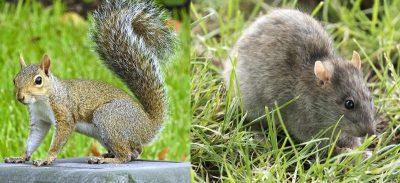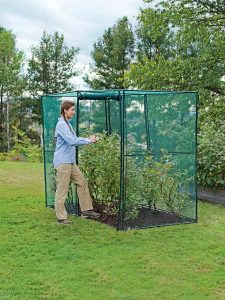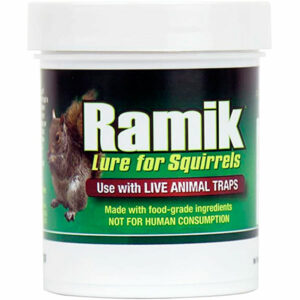Finding squirrel nests (or “dreys”) in your trees can be concerning for homeowners. While squirrels are an important part of our ecosystem, their nesting activities can lead to property damage and potential health risks. This comprehensive guide covers how to identify squirrel nests in trees, legal considerations for removal, effective removal methods, and prevention strategies to keep these persistent rodents from returning.
Squirrel Nest in Tree Identification
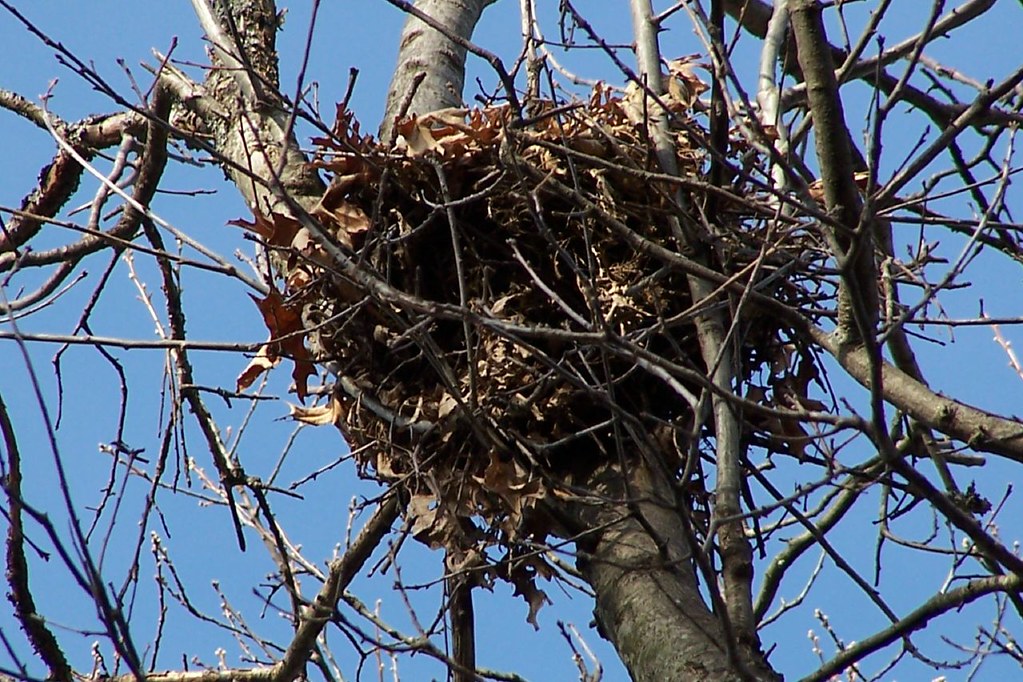
Before attempting any removal, it’s crucial to correctly identify a squirrel nest and distinguish it from other wildlife structures like bird nests. Tree squirrels construct distinctive homes that have specific characteristics:
Appearance: Squirrel dreys typically appear as clumped masses of twigs, leaves, bark, and moss, usually round or football-shaped.
Location: Usually positioned 20-30 feet high in trees, either in forked branches or tree cavities.
Timing: Nest building occurs primarily in early summer (June-July) and again in mid-fall, preparing for winter.
Squirrels often build multiple nests (typically 2-3) within their territory. These serve different purposes: primary residence, backup shelter, and practice homes for juveniles. This multiple-nest strategy also helps them evade predators.
Signs That Confirm a Squirrel Nest
- Visual confirmation of squirrels entering or exiting the nest
- Scratches in tree bark from frequent climbing
- Chewed damage on nearby structures or vegetation
- Squirrel droppings visible at the base of the tree
- Food caches or digging in yard soil or potted plants
- Multiple nests visible in nearby trees

Typical squirrel drey nest built with twigs and leaves
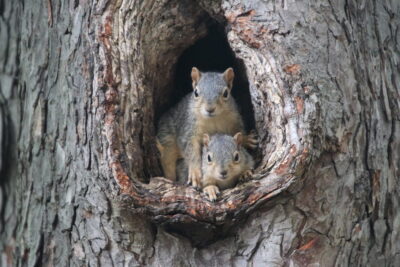
Juvenile squirrels that may occupy nests

Adult squirrel that builds and maintains nests
Legal Considerations for Squirrel Nest Removal
Before attempting to remove any wildlife nest, verify your local wildlife regulations. Many jurisdictions protect certain species, particularly during breeding seasons or if young are present.
While squirrels aren’t typically protected under the Migratory Bird Treaty Act (which prohibits disturbing active bird nests), they may have specific protections in your area. In some regions, squirrels are classified as game animals, which means their removal might require permits or may only be allowed during specific seasons.
Key legal considerations include:
- Protection status of the squirrel species in your area
- Seasonal restrictions during breeding periods
- Regulations regarding trapping and relocation
- Requirements for professional licensing for removal services
Never disturb a nest with baby squirrels present. Young squirrels stay in the nest for 10-12 weeks after birth, and removing the nest during this time can separate babies from their mother, likely resulting in their death.
6 Effective Methods for Squirrel Nest Removal
Once you’ve confirmed the nest is abandoned or have obtained any necessary permissions, here are six methods for safe and effective squirrel nest removal:
1. Hire a Professional Tree Service
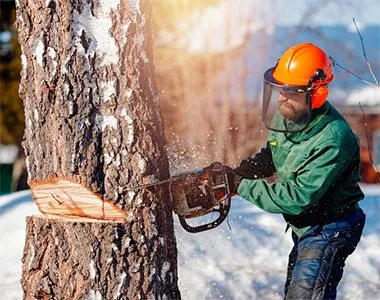
- Specialized equipment for safe high-reach access
- Ability to fill tree cavities to prevent future nesting
- Can remove multiple nests during one service
- Eliminates personal safety risks
Tree service professionals have the proper safety equipment and training to access nests at significant heights. They can also assess tree health, identify all nests, and implement preventative measures during the same service visit.
2. Contact Wildlife Control Specialists

- Knowledge of local regulations and best practices
- Ability to safely handle wildlife if present
- Can implement comprehensive prevention strategies
- Experience in humanely addressing wildlife conflicts
Wildlife specialists offer the advantage of knowing exactly how to determine if a nest is active or abandoned. They’re also trained in humane removal techniques and can provide guidance on preventing future issues.
3. DIY Long Pole Nest Removal Tool

- Cost-effective solution for accessible nests
- Eliminates ladder-related fall risks
- Can be constructed with readily available materials
- Suitable for confirmed abandoned nests
For abandoned nests at moderate heights, a DIY extension pole with a hook attachment allows you to safely dislodge the nest from ground level.
- Gather four 8-foot lengths of 2-inch diameter PVC pipe
- Connect the pipes securely to create a long extension
- Attach a garden cultivator or hook implement to the end
- Use the pole to carefully dislodge the abandoned nest
Always wear protective gear including gloves, long sleeves, and eye protection when removing nests. Position yourself so that the nest won’t fall on you when dislodged.
4. Apply Squirrel Repellents

- Discourages squirrels from returning to nests
- Available in commercial or DIY formulations
- Can be applied to tree trunks and surrounding areas
- Most effective when used consistently
Effective squirrel repellent options include:
| Repellent Type | Application Method | Reapplication Needed |
|---|---|---|
| Commercial squirrel repellent | Spray on tree trunk and lower branches | Every 7-10 days and after rain |
| Predator urine (fox, coyote) | Apply around base of tree | Weekly |
| Peppermint oil solution | Spray on trunk and accessible branches | Every 3-4 days |
| Cayenne pepper mixture | Spray around base of tree and lower trunk | After rain or every 5 days |
| Apple cider vinegar solution | Soak rags and hang in branches | Replace weekly |
5. Install Deterrent Devices
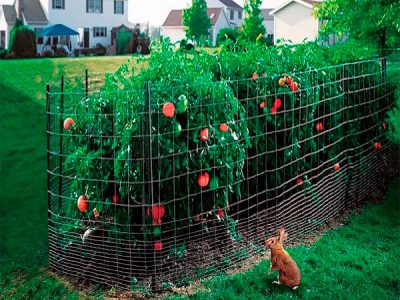
- Creates uncomfortable environment for squirrels
- Multiple deterrent types can be combined
- Non-toxic and environmentally friendly options available
- Can be permanent or temporary installations
Effective deterrents to make trees less appealing for nesting include:
- Motion-activated sprinklers positioned to spray the tree trunk
- Tree trunk baffles or metal collars that prevent climbing (minimum 24″ wide)
- Ultrasonic repellent devices that emit high-frequency sounds
- Predator decoys like owl figures (must be moved regularly)
- Wind chimes or reflective items that create noise and visual disturbances
6. Humane Trapping (Last Resort)
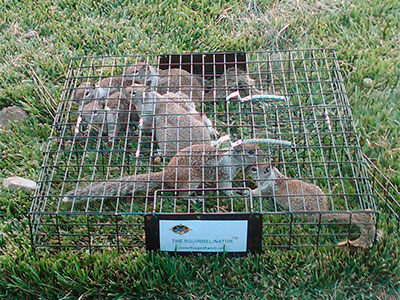
- Should only be considered when other methods fail
- Requires knowledge of local regulations
- May need professional assistance
- Must use appropriate humane trapping techniques
Many areas prohibit trapping and relocating wildlife without proper permits. Even when legal, relocated squirrels often struggle to survive in unfamiliar territories.
If you must resort to trapping, consider these guidelines:
- Use only humane live traps designed for squirrels
- Check traps frequently (at least twice daily)
- Never relocate animals more than 100-300 yards from capture site
- Release in suitable habitat with food and shelter options
Preventing Future Squirrel Nest Infestations
After successfully removing squirrel nests, take these preventative steps to discourage their return:
Tree Maintenance: Trim branches that extend to structures or hang within 8 feet of the ground.
Landscaping: Plant squirrel-repellent flora like daffodils, geraniums, and hyacinth.
Food Management: Use squirrel-proof bird feeders and promptly harvest fruits and nuts from garden trees.
Ongoing Prevention Strategies
Implementing these long-term strategies will help keep your property squirrel-free:
Effective Squirrel Prevention Tips
- Install squirrel-proof bird feeders with baffles or weight-sensitive mechanisms
- Secure trash containers with wildlife-resistant lids
- Remove fallen fruits, nuts, and seeds promptly
- Seal entry points to attics and other structures with metal flashing
- Keep firewood stacked away from trees and structures
- Regularly apply deterrents to trees with history of nesting
For particularly persistent squirrel problems, consider creating a designated feeding area far from your home and valuable trees. This can draw squirrels away from areas where you don’t want them while still allowing them to thrive in your ecosystem from a distance.
Frequently Asked Questions
Is it illegal to remove a squirrel nest from my tree?
Legal status varies by location and species. Generally, removing abandoned nests is permissible, but removing active nests, especially with young present, may be regulated. Always check local wildlife regulations before removal.
How can I tell if a squirrel nest is active or abandoned?
An active nest will show signs of recent construction (fresh materials), frequent squirrel activity around the tree, and possibly visible movement within the nest. Monitor for several days at different times to confirm activity. If no squirrels enter or exit for 7-10 days, it may be abandoned.
When is the safest time of year to remove squirrel nests?
Late fall (after breeding season) or mid-winter are typically safest, as young are less likely to be present. Avoid February-April and August-October, which are prime breeding periods when babies may be in nests.
Will squirrels damage my trees by building nests?
While nest building itself causes minimal damage, squirrels may chew bark and branches, potentially harming trees. They may also access nearby structures from tree pathways, leading to property damage.
How high can squirrels climb to build nests?
Squirrels are excellent climbers and typically build nests 20-30 feet high. However, they can climb much higher if necessary, reaching virtually any part of a tree.
When to Call a Professional
While DIY removal methods can be effective for abandoned nests, certain situations warrant professional assistance:
- Nests are extremely high or in dangerous locations
- You observe baby squirrels in or around nests
- Multiple nests require removal across your property
- Squirrels have also invaded attics or structures
- Previous removal attempts have been unsuccessful
Professional wildlife services typically charge $150-$400 for squirrel nest removal, depending on location, accessibility, and the number of nests. While this represents an investment, it ensures safe, legal, and effective resolution to your squirrel nest problems.
Conclusion
Removing squirrel nests from trees requires a careful approach that balances effectiveness with legal and ethical considerations. By correctly identifying nests, confirming they’re abandoned, and using the appropriate removal techniques, you can successfully address squirrel issues on your property.
Remember that prevention is equally important as removal. Implementing deterrents, modifying your landscape, and managing potential food sources will go a long way toward keeping squirrels from building new nests in your trees. Additionally, regularly inspecting your property for signs of squirrel activity can help you stay one step ahead. If you find that squirrels have already nested, it’s crucial to know how to remove squirrels from attic areas safely and humanely. Taking proactive steps and being vigilant can greatly reduce the chances of an infestation.
Whether you choose DIY methods or professional services, addressing squirrel nests promptly can help prevent property damage and maintain a balanced relationship with wildlife in your yard.
